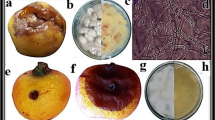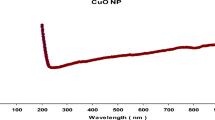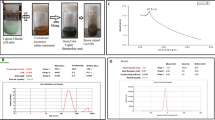Abstract
One of the most common vegetable crops in the world is the tomato (Solanum lycopersicum L). Despite an increase in the area under tomato cultivation, production has not kept up. One of the most significant obstacles to the yield of tomato crops is the Alternaria pathogen. In this study, 11 Alternaria species were isolated from tomato leaves and identified using a morphological and molecular tool based on ITS regions of the rDNA sequences. Fe (iron) nanoparticles (NPs) were created in the current investigation utilizing cow urine. The surface morphology and synthesis of metal oxide functional groups were studied using Scanner electron microscopy (SEM) and Fourier transform infrared spectroscopy (FTIR). Preliminary x-ray diffraction (XRD) reveals that Fe nanoparticles have a hexagonal structure with a space group (P63mc) (FTIR). Cow urine, Fe nanoparticles, and their combination (CU+ FeNPs) were tested for their effectiveness in vitro and in vivo against the leaf spot pathogen The lethal action of FeNPs on leaf spot may be mediated by ROS, which plays a function in NPs by inhibiting A. alternata growth. In the future, the use of CU + FeNPs combination in crop production mainly to increased yield quality, and manage diseases should be promoted. As far as we know, this is the first attempt made to manage this important pathogen (leaf spot pathogen) in tomato plants using a combination of CU + FeNPs together under field conditions.








Similar content being viewed by others
Data availability
Data supporting the conclusions of this article are presented in the main manuscript.
Abbreviations
- SEM:
-
Scanning Electron Microscope
- TEM:
-
Transmission Electron Microscope
- XRD:
-
X-ray Diffraction
- FTIR:
-
Fourier Transform Infrared Spectroscopy
- NPs:
-
Nanoparticles
- FeNPs:
-
Iron Nanoparticles
- ITS:
-
Internal Transcribed Spacer
References
Adinarayana, S., & Ilavarasan, E. (2018). An efficient decision tree for imbalance data learning using confiscate and substitute technique. Materials Today: Proceedings, 5(1), 680–687.
Akarsh, S., Pavithra, G., Roopa, K., Ranjitha, M., & Prashith Kekuda, T. (2016). Antifungal activity of cow urine extracts of selected plants against phytopathogenic fungi. Scholars Journal of Agriculture and Veterinary Sciences, 3(4), 305–308.
Akhter, N., Begum, M. F., Alam, S., & Alam, M. S. (2006). Inhibitory effect of different plant extracts, cow dung and cow urine on conidial germination of Bipolaris sorokiniana. Journal of Bio-Science, 14, 87–92.
Amin, R., Sarker, B., Adhikary, S., Sultana, S., & Zubair, T. (2013). Effect of some botanical extracts and cow’surfline on Sclerotium rolfsii causal agent of foot and root rot of betel vine. The International Journal of Engineering and Science, 2(9), 77–82.
Antony, D., Yadav, R., & Kalimuthu, R. (2021). Accumulation of Phyto-mediated nano-CeO2 and selenium doped CeO2 on Macrotyloma uniflorum (horse gram) seed by nano-priming to enhance seedling vigor. Biocatalysis and Agricultural Biotechnology, 31, 101923.
Bais, R. K., Ratan, V., Kumar, S., & Tiwari, A. (2019). Comparative analysis of various strategies for management of early blight of tomato incited by Alternaria solani (Ellis and Martin) Jones and Grout. The Pharma Innovation Journal, 8(12), 15–20.
Balmant, K. M., Parker, J., Yoo, M.-J., Zhu, N., Dufresne, C., & Chen, S. (2015). Redox proteomics of tomato in response to Pseudomonas syringae infection. Horticulture Research, 2(1), 1–12.
Chowdappa, P., Kumar, N. B., Madhura, S., Kumar, M. S., Myers, K. L., Fry, W. E., et al. (2013). Emergence of 13_ A 2 Blue Lineage of Phytophthora infestans was responsible for severe outbreaks of Late Blight on tomato in South-West India. Journal of Phytopathology, 161(1), 49–58.
Consolo, V. F., Torres-Nicolini, A., & Alvarez, V. A. (2020). Mycosinthetized Ag, CuO and ZnO nanoparticles from a promising Trichoderma harzianum strain and their antifungal potential against important phytopathogens. Scientific Reports, 10(1), 1–9.
Edwards, A. (1975). HP Klug and LE Alexander, x-ray diffraction procedures for polycrystalline and amorphous materials: Wiley-Interscience, New York, 2nd edn., 1974, xxv+ 966 pp. price£ 18.55. In: Elsevier.
Gerszberg, A., Hnatuszko-Konka, K., Kowalczyk, T., & Kononowicz, A. K. (2015). Tomato (Solanum lycopersicum L.) in the service of biotechnology. Plant Cell, Tissue and Organ Culture (PCTOC), 120(3), 881–902.
Gul, Z., Ahmed, M., Khan, Z. U., Khan, B., & Iqbal, M. (2016). Evaluation of tomato lines against Septoria leaf spot under field conditions and its effect on fruit yield. Agricultural Sciences, 7(4), 181–186.
Happy, A., Soumya, M., Kumar, S. V., Rajeshkumar, S., Sheba, R. D., Lakshmi, T., & Nallaswamy, V. D. (2019). Phyto-assisted synthesis of zinc oxide nanoparticles using Cassia alata and its antibacterial activity against Escherichia coli. Biochemistry and Biophysics Reports, 17, 208–211.
Huang, J., Shian, S., Diebold, R. M., Suo, Z., & Clarke, D. R. (2012). The thickness and stretch dependence of the electrical breakdown strength of an acrylic dielectric elastomer. Applied Physics Letters, 101(12), 122905.
Iqbal, T., Altaf, S., & Dar, J. A. (2019). Status of early blight [Alternaria solani (Ellis and Martin) jones and grout] disease of tomato in Kashmir. Journal of Pharmacognosy and Phytochemistry, 8, 2152–2154.
Jamdagni, P., Rana, J. S., Khatri, P., & Nehra, K. (2018). Comparative account of antifungal activity of green and chemically synthesized zinc oxide nanoparticles in combination with agricultural fungicides. International Journal of Nano Dimension, 9(2), 198–208.
Jarald, E., Edwin, S., Tiwari, V., Garg, R., & Toppo, E. (2008). Antioxidant and antimicrobial activities of cow urine. Global Journal of Pharmacology, 2(2), 20–22.
Jiang, N., Meng, J., Cui, J., Sun, G., & Luan, Y. (2018). Function identification of miR482b, a negative regulator during tomato resistance to Phytophthora infestans. Horticulture Research, 5(1), 1–11.
Kazempour, Z. B., Yazdi, M. H., Rafii, F., & Shahverdi, A. R. (2013). Sub-inhibitory concentration of biogenic selenium nanoparticles lacks post antifungal effect for Aspergillus niger and Candida albicans and stimulates the growth of Aspergillus niger. Iranian Journal of Microbiology, 5(1), 81.
Kora, A. J., Mounika, J., & Jagadeeshwar, R. (2020). Rice leaf extract synthesized silver nanoparticles: An in vitro fungicidal evaluation against Rhizoctonia solani, the causative agent of sheath blight disease in rice. Fungal Biology, 124(7), 671–681.
Kumar, A. R., Singh, B., Singh, A., Moharana, D., & Singh, R. (2017). Bioefficacy studies of new fungicidal formulations against Cercospora leaf spot and powdery mildew of chilli (Capsicum annuum L.) cv. Punjab Guchhedar. Research on Crops, 18(4), 758–761.
Kumari, M., Bairwa, S. L., Meena, L., & Rahman, S. M. (2017). Availability and post-harvest losses of fruits and vegetable in Bihar: Economic analysis. International Journal of Agricultural Invention, 1, 207–212.
Kurucheve, V., Ezhilan, J. G., & Jayaraj, J. (1997). Screening of higher plants for fungitoxicity against Rhizoctonia solani in vitro. Indian Phytopathology, 50(2), 235–241.
Loganathan, M., Venkataravanappa, V., Saha, S., Rai, A. B., Tripathi, S., Rai, R. K., et al. (2016). Morphological, pathogenic and molecular characterizations of Alternaria species causing early blight of tomato in Northern India. Proceedings of the National Academy of Sciences, India Section B: Biological Sciences, 86(2), 325–330.
Mamgain, A., Roychowdhury, R., & Tah, J. (2013). Alternaria pathogenicity and its strategic controls. Research Journal of Biology, 1, 1–9.
Murugan, A., Shanthi, S., Arunachalam, C., Sivakumar, N., Elamathy, S., & Rajapandian, K. (2012). Study on cow urine and. African Journal of Biotechnology, 11(40), 9591–9598.
Narwal, S., Balasubrahmanyam, A., Sadhna, P., Kapoor, H., & Lodha, M. (2001). A systemic resistance inducing antiviral protein with N-glycosidase activity from Bougainvillea x buttiana leaves. Indian Journal of Experimental Biology, 39(6), 600–603.
Olaniyi, J., Akanbi, W., Adejumo, T., & Ak, O. (2010). Growth, fruit yield and nutritional quality of tomato varieties. African Journal of Food Science, 4(6), 398–402.
Olivieri, F., Prasad, V., Valbonesi, P., Srivastava, S., Ghosal-Chowdhury, P., Barbieri, L., et al. (1996). A systemic antiviral resistance-inducing protein isolated from Clerodendrum inerme Gaertn. is a polynucleotide: adenosine glycosidase (ribosome-inactivating protein). FEBS Letters, 396(2–3), 132–134.
Pawar, P. R., Bhosale, A. M., & Lolage, Y. P. (2016). Early blight of tomato. Phytopathology, 68, 1354–1358.
Prins, T. W., Tudzynski, P., von Tiedemann, A., Tudzynski, B., Ten Have, A., Hansen, M. E., et al. (2000). Infection strategies of Botrytis cinerea and related necrotrophic pathogens. In Fungal pathology (pp. 33–64): Springer.
Raheem, D., Dayoub, M., Birech, R., & Nakiyemba, A. (2021). The contribution of cereal grains to food security and sustainability in Africa: potential application of UAV in Ghana, Nigeria, Uganda, and Namibia. Urban Science, 5(1), 8.
Rakesh, K., Dileep, N., Nawaz, N., Junaid, S., & Kekuda, P. (2013). Antifungal activity of cow urine against fungal pathogens causing rhizome rot of ginger. Environment and Ecology, 31(3), 1241–1244.
Ritmontree, S., & Kongtragoul, P. (2020). Antifungal effect of zinc oxide nanoparticles against disease in durian caused by Phytophthora palmivora. In III Asian Horticultural Congress-AHC2020 1312 (pp. 423–430).
Rui, M., Ma, C., Hao, Y., Guo, J., Rui, Y., Tang, X., et al. (2016). Iron oxide nanoparticles as a potential iron fertilizer for peanut (Arachis hypogaea). Frontiers in Plant Science, 7, 815.
Sarsar, V., Selwal, K. K., Selwal, M. K., Pannu, R., & Tyagi, P. K. (2013). Evaluation of antibacterial activity of photoactivated cow urine against human pathogenic strains. Environmental and Experimental Biology, 11, 201–203.
Sharma, S., Kumari, P., Thakur, P., Brar, G. S., Bouqellah, N. A., & Hesham, A. E.-L. (2022). Synthesis and characterization of Ni0. 5Al0. 5Fe2O4 nanoparticles for potent antifungal activity against dry rot of ginger (Fusarium oxysporum). Scientific Reports, 12(1), 20092.
Shenashen, M. A., El-Safty, S. A., & Elshehy, E. A. (2014). Synthesis, morphological control, and properties of silver nanoparticles in potential applications. Particle & Particle Systems Characterization, 31(3), 293–316.
Shinde, B. A., Dholakia, B. B., Hussain, K., Aharoni, A., Giri, A. P., & Kamble, A. C. (2018). WRKY1 acts as a key component improving resistance against Alternaria solani in wild tomato, Solanum arcanum Peralta. Plant Biotechnology Journal, 16(8), 1502–1513.
Sidhu, A., Bala, A., Singh, H., Ahuja, R., & Kumar, A. (2020). Development of MgO-sepoilite nanocomposites against Phytopathogenic fungi of rice (Oryzae sativa): A green approach. ACS Omega, 5(23), 13557–13565.
Singh, H., & Kaur, T. (2020). Pathogenicity of entomopathogenic fungi against the aphid and the whitefly species on crops grown under greenhouse conditions in India. Egyptian Journal of Biological Pest Control, 30(1), 1–9.
Sreenivasulu, R., Reddy, M. S. P., Tomar, D., Sanjay, M. S. S., & Reddy, B. B. (2019). Managing of early blight of tomato caused by Alternaria solani through fungicides and bioagents. International Journal of Current Microbiology and Applied Sciences, 8(6), 1442–1452.
Tai, W., He, L., Zhang, X., Pu, J., Voronin, D., Jiang, S., et al. (2020). Characterization of the receptor-binding domain (RBD) of 2019 novel coronavirus: Implication for development of RBD protein as a viral attachment inhibitor and vaccine. Cellular & Molecular Immunology, 17(6), 613–620.
Thakur, S., Thakur, S., & Kumar, R. (2018). Bio-nanotechnology and its role in agriculture and food industry. Journal of Molecular and Genetic Medicine, 12(324), 1747–0862.1000324.
Tiwari, R., & Das, K. (2011). Inhibitory effect of cow urine based plant extracts against Rhizoctonia solani causing sheath blight of rice. Indian Phytopathology, 64(3), 265.
Vincent, J. (1947). Distortion of fungal hyphae in the presence of certain inhibitors. Nature, 159(4051), 850–850.
Vleeshouwers, V. G., van Dooijeweert, W., Govers, F., Kamoun, S., & Colon, L. T. (2000). The hypersensitive response is associated with host and nonhost resistance to Phytophthora infestans. Planta, 210(6), 853–864.
White, T. J., Bruns, T., Lee, S., & Taylor, J. (1990). Amplification and direct sequencing of fungal ribosomal RNA genes for phylogenetics. PCR Protocols: A Guide to Methods and Applications, 18(1), 315–322.
Yu, J., Zhang, W., Li, Y., Wang, G., Yang, L., Jin, J., et al. (2014). Synthesis, characterization, antimicrobial activity and mechanism of a novel hydroxyapatite whisker/nano zinc oxide biomaterial. Biomedical Materials, 10(1), 015001.
Zhang, D., Yu, S., Yang, Y., Zhang, J., Zhao, D., Pan, Y., et al. (2020). Antifungal effects of volatiles produced by Bacillus subtilis against Alternaria solani in potato. Frontiers in Microbiology, 11, 1196.
Acknowledgements
We would like to thank the research teams for their invaluable assistance throughout the present study.
Funding
Not applicable.
Author information
Authors and Affiliations
Contributions
All authors conceived, designed, analyzed, wrote, corrected and approved the final manuscript. All authors read and approved the final manuscript.
Corresponding author
Ethics declarations
Ethics approval and consent to participate
Not applicable.
Consent for publication
Not applicable.
Competing interests
The manuscript contains original research findings and there is no conflict of interest.
Rights and permissions
Springer Nature or its licensor (e.g. a society or other partner) holds exclusive rights to this article under a publishing agreement with the author(s) or other rightsholder(s); author self-archiving of the accepted manuscript version of this article is solely governed by the terms of such publishing agreement and applicable law.
About this article
Cite this article
Sharma, S., Bouqellah, N.A., Kaur, T. et al. Cow urine mediated biogenically generated FeNP to boost antimycotic activity against leaf spot pathogen. Eur J Plant Pathol 168, 541–555 (2024). https://doi.org/10.1007/s10658-023-02783-z
Accepted:
Published:
Issue Date:
DOI: https://doi.org/10.1007/s10658-023-02783-z




